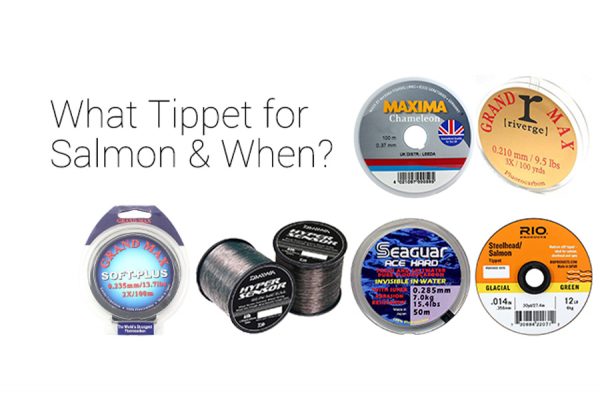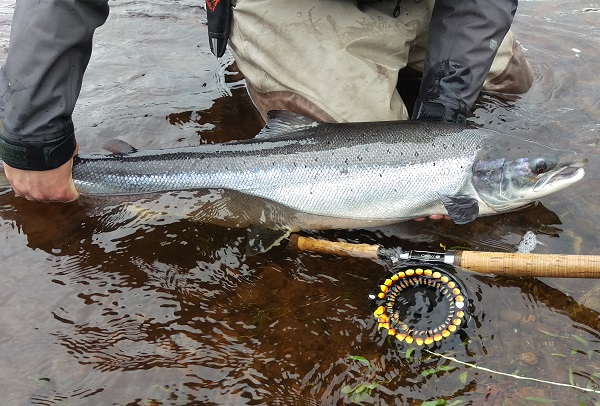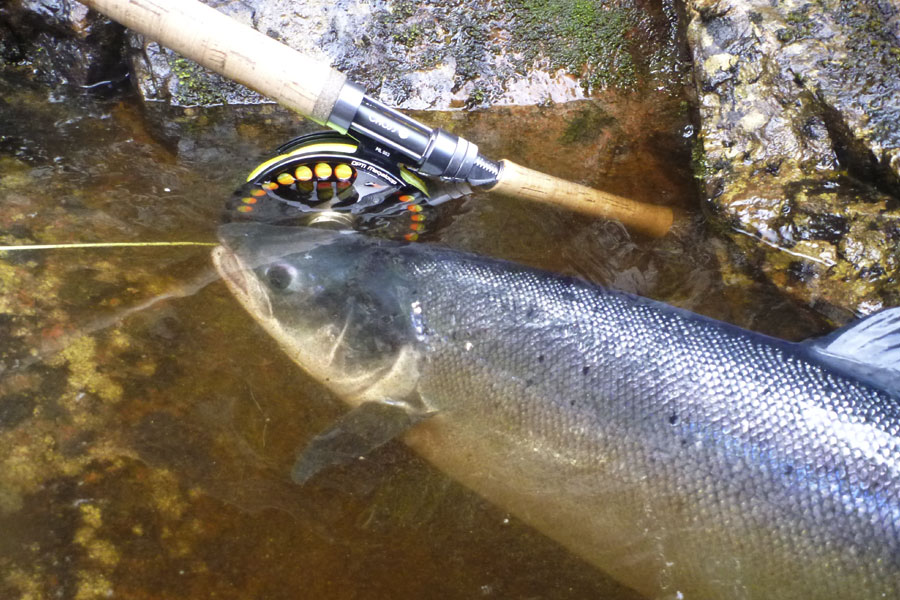
There are a few simple reasons for the huge range of tippet materials available to Salmon fly anglers. This article explains why you should explore and expand what tippet you keep in your kit.
“How do I choose a spool of tippet material for a salmon fly leader when there are so many different types, colours, and thicknesses?” asked a recent customer.
Good question! When Springers are running and they are straight off the tide, we would say the type of tippet material you use makes little to no difference (except strong 15-30lb) because these fish are less wary and in an aggressive mood. However, when fishing for salmon that have slowed down a little, we offer you the below advice.
Considering that on offer at Angling Active we have various types of nylon, copolymer, and the fashionable fluorocarbon… Indeed, how do you choose?
Some questionable facts…
- – We (Angling Active) question all the hype about fluoro? It isn’t invisible in all conditions as some say, and it can cast a shadow just like all other tippet materials. However, it does have a solid place in a salmon fly anglers’ arsenal.
- – The myth that there’s only one type of tippet that suits every scenario is, no better a word for it, “rubbish”, and we’ll explain a few very simple things that hopefully will help you catch more fish, specifically Salmon.
In writing this I can hear some of you grumble that this is just a sales pitch to sell more types of leader material, and that you believe all you need is the infamous and trusty nylon called Maxima, well we almost agree with that. What I will do straight away is tell you that we have found no use for the new-to-market “Copolymer” material in salmon angling within the UK, yet it has such a strong presence in the trout fly world, more on this in a future blog post.
So to the obvious (once explained)
Just like choosing the rod, line, polyleader(tips) and fly for a particular river in particular conditions, your choice in nylon or fluorocarbon is just the same. Would you use a skagit line in a low summer-level water? “No”. Would you use a size 16 micro fly in early Spring? “No”. So why would you swing dark nylon in gin clear water, use stiff fluorocarbon on tiny flies, or even use soft nylon on heavy tubes? Do you know?
Colour?
Colour is the first factor to consider in tippet material choice. A few anglers already know that colour can make a huge difference. Take for example Maxima. This nylon isn’t the thinnest in the world, and many would argue it is cheap for a reason, but the nylon does come in 3 colours which is more than can be said for other bigger names. The Chameleon colour (dark brown) is the original colour that goes way back a couple of generations and many still religiously use it. This colour is ideal for peaty/tannic water in overcast conditions. The Ultragreen is excellent for brighter conditions in these peaty waters, but even more so for most other Scottish rivers except for the really clear ones. And you guessed it, the Clear Maxima is a reasonably good choice for clearer and low rivers, but it is quite thick in comparison to fluorocarbons. From this example, use the theory to choose clear fluorocarbon over darker nylon and vice versa depending on the colour and height of the river.
Stiff or Supple?
Generally nylon is more supple than fluorocarbon. When you cast out a heavy tube fly, you have to work the rod and line a little harder and your timing has to be good. In order to transfer energy down the line right to the fly and hopefully flick it over with less effort, choose a high breaking strain fluorocarbon.
At the opposite end of the spectrum, when you are fishing tiny flies, use thinner nylon. The reason being there isn’t as much weight in the fly to worry about presenting it properly. Another great reason for thin nylon with tiny flies is that it is supple and will aid movement. Small flies have very little movement because they are sparsely dressed, so every ripple or bit of turbulence the fly drifts through helps how realistic and attractive it looks. Give your small flies more life with supple nylon.
Thickness and Breaking Strain?
This is often a confusing one. Similar thicknesses of two nylons/fluorocarbons, does not mean they are the same strength, far from it in fact. It is not difficult to find out the diameter however because the line diameter is stated on most spool labels. For your information, printed next to the breaking strain of the tippet is a number followed by the letter X. The higher the X number the thinner the line i.e. “5X”, “2X” etc. This number and X is a reference to how many times (“x”) the nylon/fluoro/copolymer is passed through the die (small hole the nylon is passed through to make it thinner) in the manufacturing stage. 5X has been passed through a die 5 times. 3X = 3 times etc. Thicker tippet material (1X, 2X, 3X) can turn over heavier flies, the thinner (4X, 5X etc) will be less visible to the fish.
Knot so simple…
We, as in “most” of the salmon anglers in store at Angling Active, believe that nylon provides better knot strength than fluorocarbon. Because nylon is easier to compress than fluorocarbon, knots bed-down better and don’t hinge into weakened joints, this is less of an issue the higher the breaking strain you are using e.g. 30lb fluorocarbon will provide all the knot strength a salmon angler will hopefully ever need, whereas 12lb fluorocarbon will not perform so well at the knot as nylon would.
The Cherry on top
In Summer conditions on long slow glassy pools, all you may need is a size #10-12 double fly or two on a long bellied floating Spey line or your trusty shooting head. There is a benefit to Fluoro over nylon in this circumstance . Fluorocarbon sinks and it is less likely to get stuck and hang in the surface film. This brings your tippet just under the surface without affecting the position of the fly, but it stops knots dragging on the surface making a slight wake. Again this is really only a key decision for very slow/glassy pools.
Summary
From these generalised remarks, you will now realise that when you are planning what equipment to take to a particular river, have a selection of nylon and fluorocarbon spools in varying breaking strains. Not that you can prove it, but it might just make the difference between a great day and a blank day. For more info, ask us online, over the phone or come in to our Stirling store.






